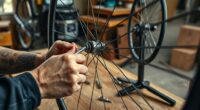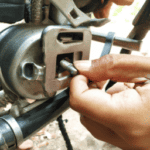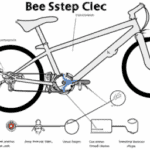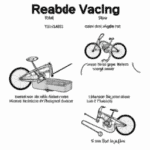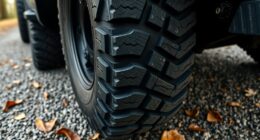Before starting your home bike tune-up, gather your tools and check they’re in good condition, ensuring your work area is stable, well-lit, and clutter-free. Wear safety gear like a helmet, gloves, and eye protection to stay safe. Secure and disconnect moving parts, especially wheels and pedals, to prevent accidents. Use proper techniques for adjustments and handle sharp or rotating components carefully. If you follow these safety tips, you’ll keep yourself safe and your bike in top shape—learn more as you continue.
Key Takeaways
- Organize tools and workspace to prevent accidents and ensure easy access during maintenance.
- Inspect the bike thoroughly for damage, loose parts, and proper tire pressure before starting work.
- Wear appropriate safety gear such as helmets, gloves, and eye protection to prevent injuries.
- Secure the bike and use proper tools when adjusting components to avoid slips or damage.
- Conduct safety checks and test ride the bike after maintenance to confirm it’s safe to ride.
Gather the Necessary Tools Safely

Before you begin your bike tune-up, make sure to gather all the necessary tools carefully to avoid accidents. Start by organizing your tools in a designated workspace, keeping your bike storage area tidy. Proper tool organization helps you quickly find what you need and reduces the risk of dropping or misplacing tools. Use a toolbox or a pegboard to keep wrenches, screwdrivers, and other essentials within reach. Check that all tools are in good condition and free from damage. Avoid clutter around your work area to prevent slips or falls. By being deliberate about your tool setup and maintaining an organized space, you create a safer environment for your bike maintenance. Remember, a well-organized workspace minimizes hazards and makes your tune-up more efficient. Ensuring your tools are in good condition and suitable for the task at hand also enhances safety during your project.
Inspect Your Bike Before Starting

Inspecting your bike thoroughly before starting guarantees you identify any issues that could cause problems during the tune-up. Start by examining the bike frame for cracks, rust, or dents that might compromise safety. Check the tire pressure to ensure it’s within the recommended range; under- or over-inflated tires can lead to flats or poor handling. Look over the tires for embedded debris, cuts, or worn tread that might need replacing. Spin the wheels to see if they wobble or if the spokes are loose. Confirm that quick-release levers or bolts are secure. This initial inspection helps prevent surprises later, saving you time and ensuring your bike is safe to ride after the tune-up. Additionally, inspecting the knitting kits for kids can inspire patience and attention to detail, which are valuable skills during bike maintenance.
Wear Appropriate Safety Gear
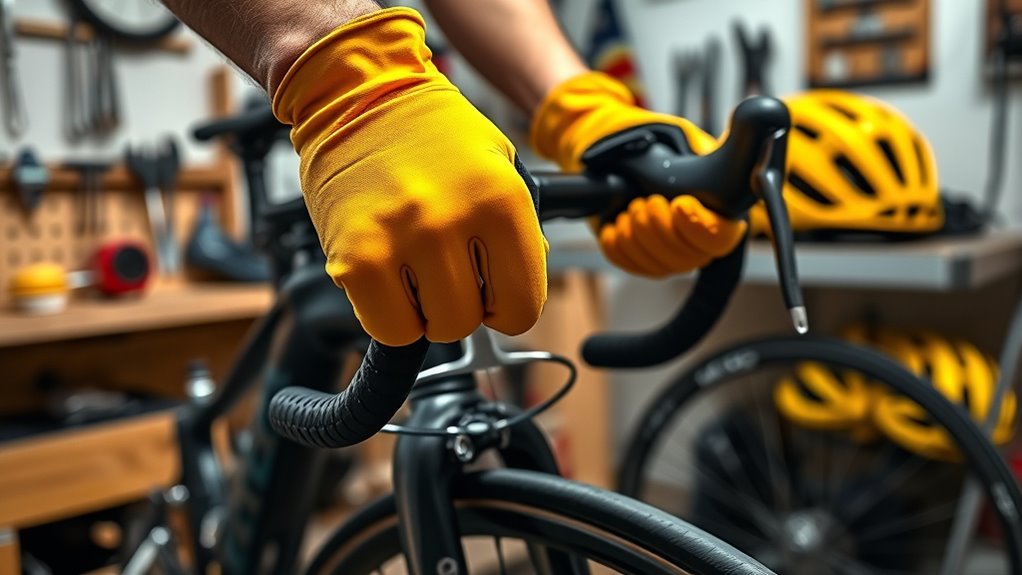
Wearing the right safety gear keeps you protected while working on your bike. Make sure your helmet fits snugly, gloves enhance your grip, and eye protection shields you from debris. These essentials help you stay safe and focused during the tune-up. Additionally, utilizing appropriate tuning tools ensures your work is both safe and effective.
Wear Helmet Properly
A properly worn helmet is essential for protecting yourself during a bike tune-up. Ensuring the helmet fit is snug but comfortable, with the straps securely fastened under your chin, is key. The helmet style should suit your head shape and personal comfort, making you more likely to wear it consistently. When worn correctly, your helmet can:
- Protect your head from unexpected impacts and falls
- Boost your confidence to work safely on your bike
- Instill a sense of responsibility for your safety
- Remind you that safety always comes first
- Incorporating safety gear like helmets can significantly reduce injury risks during maintenance.
Use Gloves for Grip
Choosing the right gloves while working on your bike can substantially improve your grip and control. Quality gloves grip the handlebars and tools securely, preventing slips that could cause injury. They also provide essential hand protection from cuts, scrapes, and dirt. When selecting gloves, opt for ones that fit snugly without restricting movement or blood flow. Look for materials that offer durability and a good grip, like rubberized or textured surfaces. Wearing gloves keeps your hands clean and reduces the risk of blisters during extended work sessions. They’re especially useful when handling greasy or sharp components. By protecting your hands and enhancing your grip, gloves make your bike tune-up safer and more efficient, allowing you to focus on the task without worry. Proper glove selection is crucial for maintaining safety and efficiency during your maintenance tasks.
Eye Protection Essential
Since bike maintenance involves working with greasy, sharp, or moving parts, protecting your eyes is essential to prevent injury. Wearing proper eye protection, like safety goggles, keeps debris, grease splashes, and flying fragments away from your eyes. Without it, a tiny spark or splash could cause permanent damage or blindness. Photobombs by children and pets can also unexpectedly occur during home repairs, making protective gear even more important. Remember, accidents happen quickly, and safety goggles are your first line of defense. Keep your eyes safe by:
- Shielding yourself from unexpected splashes
- Preventing tiny particles from causing irritation
- Avoiding painful debris in your eyes
- Reducing the risk of serious injury during repairs
Invest in quality eye protection and always wear safety goggles during your bike tune-up. Your vision is priceless—protect it with the right gear.
Find a Stable and Clear Work Area
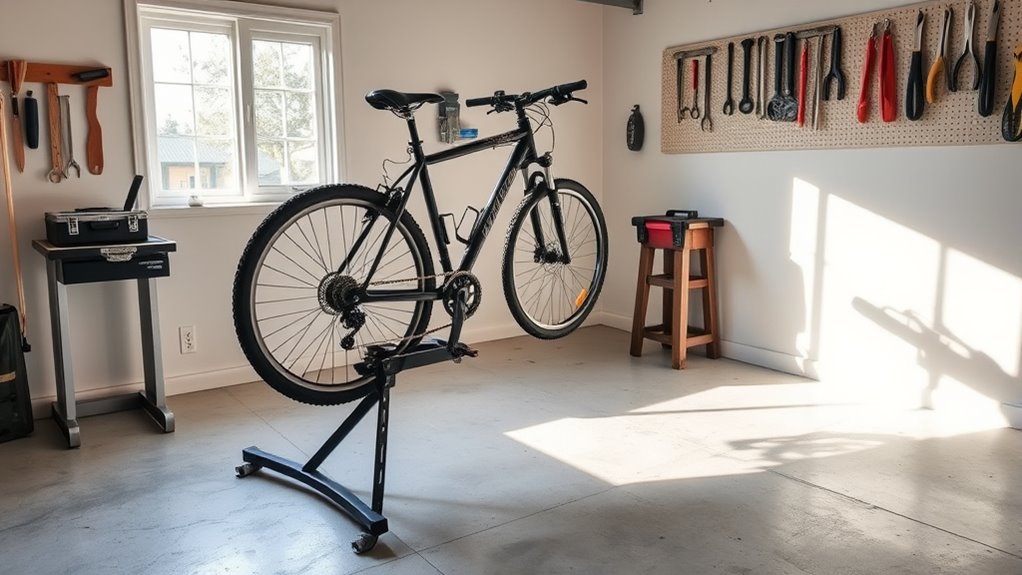
Make sure your work area is clear of clutter and obstacles before starting. Choose a level ground to keep your bike stable and prevent accidents. Remove any tools or objects that could cause trips or falls during your tune-up. Additionally, ensure your workspace is well-lit to improve visibility and safety. Floor stability is essential for a secure and effective bike maintenance session.
Clear Surroundings Essential
Ensuring your work area is stable and clear is essential for a safe and efficient bike tune-up. A cluttered or unstable space can lead to accidents or damage to your bike. Clear your surroundings to prevent tripping over tools or bike parts. Keep your bike storage organized so you can find what you need quickly, avoiding frustrating delays. Make sure there’s enough room to move freely, especially if you’re working on different parts. A tidy space also helps you focus on your cycling fashion choices, making the process more enjoyable. Additionally, being aware of family influences can remind you of the importance of creating a safe environment at home.
- Feel confident knowing your work area supports your safety
- Experience the satisfaction of a well-organized space
- Enjoy peace of mind while working on your bike
- Prevent accidents caused by clutter or instability
Level Ground Preference
A level, stable surface is essential for a safe and effective bike tune-up. Choosing the right terrain preferences guarantees your bike stays steady and your work remains safe. Look for flat surface considerations like driveways, garage floors, or paved patios. These provide a reliable foundation and minimize the risk of slipping. Here’s a visual for your ideal work area:
| Flat Surface Considerations | Terrain Preferences |
|---|---|
| Smooth, firm ground | Concrete or asphalt |
| Clear of debris | Level, even terrain |
| Well-lit and ventilated | Stable, non-slippery |
This setup helps you work confidently, reduces accidents, and ensures your bike stays secure during the tune-up. Prioritize safety by selecting the best ground for your project. Proper workspace enhances safety and efficiency during your bike maintenance.
Remove Obstructions First
Before starting your bike tune-up, clear the work area of any obstructions. Removing clutter ensures a safe, stable workspace, reducing the risk of accidents. Obstruction removal is vital for maintaining workspace safety, preventing slips or falls. A tidy area helps you focus and work efficiently without surprises. Consider these tips to create a safe zone:
- Eliminate tripping hazards that could cause falls.
- Clear tools and parts to avoid accidental injuries.
- Ensure adequate lighting for better visibility.
- Secure loose items that could interfere with your work or cause damage.
- Remember that water safety is essential around any work area, especially if you’re near pools or aquatic equipment.
A clean, obstacle-free space keeps you confident and safe while working on your bike. Prioritize obstruction removal, and you’ll enjoy a more efficient and secure tune-up. Your safety depends on a clutter-free environment!
Disconnect or Secure Moving Parts

To prevent accidents while working on your bike, you should disconnect or securely fasten all moving parts. Start by loosening the chain to avoid it catching or snapping unexpectedly during maintenance. Ensuring proper chain lubrication can also prevent sudden movement and reduce resistance, making adjustments safer. Check that the tires have the correct pressure; under- or over-inflated tires can cause slips or unexpected rolls. Secure any loose components, such as quick-release skewers or pedals, to prevent them from shifting or spinning while you work. Removing or locking the derailleur and brakes can further prevent accidental engagement. Taking these steps keeps your hands and tools safe, reducing the risk of injury and ensuring a smooth, efficient tune-up. Additionally, understanding the importance of personal and community resilience can help you better prepare for emergencies that may impact your ability to maintain your bike safely.
Use Correct Techniques for Adjustments

When making adjustments on your bike, using the correct techniques guarantees safety and effectiveness. Proper adjustment safety depends on your method, so take your time and follow precise steps. A correct technique minimizes the risk of damaging components or causing injury. Keep these points in mind:
- Stay focused; rushed adjustments can lead to mistakes.
- Use the right tools for each adjustment to avoid stripping or slipping.
- Apply gradual force; avoid forcing parts into position.
- Follow manufacturer instructions carefully to ensure proper alignment.
- Be aware of proper maintenance practices to ensure your bike remains in optimal condition over time.
Mastering correct technique ensures your bike functions smoothly and reduces the chance of accidents. When you prioritize adjustment safety, you protect yourself and extend your bike’s lifespan. Confidence in your adjustments makes riding safer and more enjoyable.
Be Cautious With Sharp or Rotating Components

Sharp edges and moving parts can pose serious safety risks during a home bike tune-up. Always handle sharp components, like exposed brake or derailleur edges, with care to avoid cuts. Be cautious around rotating parts such as the chain, cranks, and gears—they can catch clothing or fingers unexpectedly. Before working near these moving elements, stop the bike and secure it properly. Use tools carefully to avoid slipping onto sharp or rotating components. Keep your hands and tools away from spinning wheels or pedals to prevent injury. Wearing gloves can provide extra protection against sharp edges. If you need to adjust or inspect rotating parts, do so when the bike is stationary and supported firmly. Staying alert helps prevent accidents caused by sharp components or rotating parts during your tune-up. Recognizing the importance of safety in maintenance is essential in avoiding injuries and ensuring a successful bike tune-up.
Test Your Work Carefully Before Riding

After completing your adjustments, take the time to thoroughly test your bike before hitting the road. This step is vital for guaranteeing bike safety and confirming your maintenance checklist was followed correctly. Carefully check that brakes are responsive, gears shift smoothly, and tires are properly inflated. Test ride in a safe area, paying attention to any unusual noises or handling issues. Make sure your quick releases are secure, and handlebars are straight. Remember, a quick inspection can prevent accidents. Proper testing procedures help ensure your bike functions safely and reliably.
- Feel confident that your brakes stop effectively
- Ensure gears shift seamlessly without slipping
- Confirm tires are secure and properly inflated
- Notice any strange sounds or vibrations early on
Taking these precautions helps you ride safely and enjoy your bike with peace of mind. Always prioritize testing your work before every ride.
Maintain Regular Safety Checks Post-Tune-Up
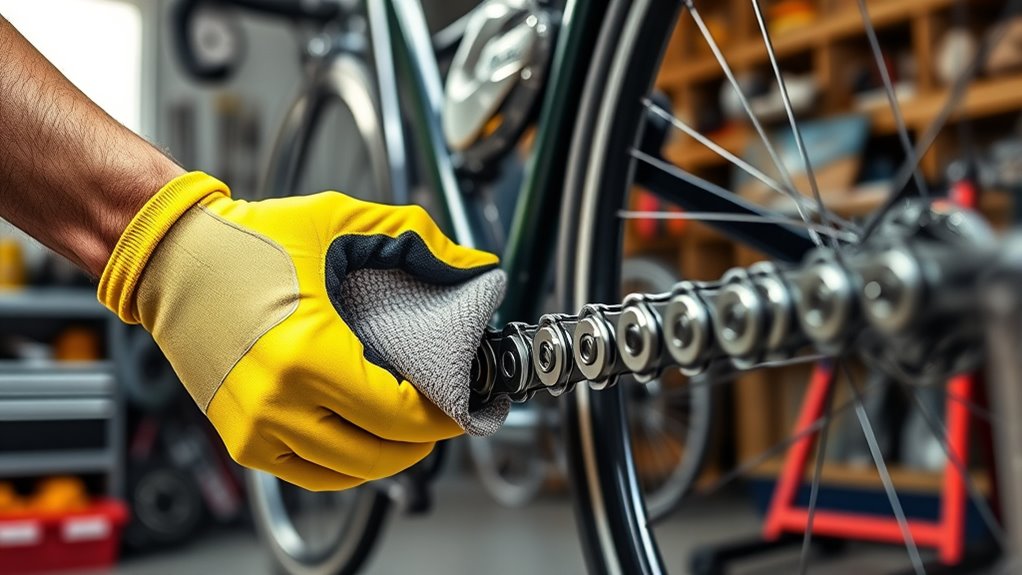
Regular safety checks after your tune-up are essential to keep your bike in top condition and guarantee ongoing safety. After each ride, inspect your bike’s tires, brakes, and gears to catch any issues early. Proper bike storage also helps preserve your bike’s condition; keep it in a dry, secure place to prevent rust and damage. Remember to follow riding etiquette by checking your signals, maintaining safe distances, and being aware of your surroundings. Regularly tightening bolts and inspecting cables ensures everything stays secure. Additionally, paying attention to preventative maintenance can help identify potential problems before they become serious. These quick safety checks help prevent accidents and extend your bike’s lifespan. Staying attentive to your bike’s condition and practicing good riding habits makes every ride safer and more enjoyable. Consistent maintenance keeps your bike ready for any adventure.
Frequently Asked Questions
How Often Should I Perform a Home Bike Tune-Up?
You should perform a home bike tune-up every 6 to 8 weeks or whenever you notice issues like squeaking, sluggish gears, or decreased braking performance. Incorporate a bike maintenance schedule that includes seasonal tune-up tips, such as checking tire pressure and lubricating parts. Regular tune-ups keep your bike running smoothly, extend its lifespan, and guarantee safety on every ride. Don’t wait—stay proactive with your bike care!
What Are Common Signs My Bike Needs Maintenance?
You’ll notice your bike needs maintenance if the bike cleaning reveals excessive dirt or grime, or if your tires lose pressure frequently. Also, watch for sluggish shifting or squeaky brakes, which indicate parts may need lubrication or adjustment. Keep an eye on tire pressure to ensure smooth rides, and regularly inspect for any signs of wear or damage. Addressing these signs promptly keeps your bike running safely and efficiently.
Can I Tune up My Bike Without Prior Experience?
Yes, you can tune up your bike without prior experience if you follow DIY basics and choose the right tools. Start by learning simple tasks like adjusting brakes and lubricating the chain. Select essential tools such as Allen wrenches, a tire pump, and screwdrivers. Watch tutorial videos or read guides to build confidence. Take your time, work carefully, and don’t hesitate to seek advice if needed.
What Should I Do if I Encounter a Stuck or Damaged Part?
When facing a stuck or damaged part, think of it as a puzzle piece that needs gentle handling. First, put on your safety gear to protect yourself. Use your repair tools carefully, applying steady pressure to avoid further damage. If the part won’t budge, don’t force it—consult a professional. Patience and proper tools are your best allies, ensuring your bike stays safe and sound for the ride ahead.
Are There Specific Safety Precautions for Electric Bikes?
When working on your electric bike, prioritize battery safety by wearing gloves and eye protection. Always unplug the battery before starting maintenance to prevent electrical hazards. Handle the battery carefully to avoid punctures or damage, and keep it away from heat or water. Follow the manufacturer’s instructions for charging and storage. Being cautious with electrical components helps prevent shocks, fires, and other safety issues during your home tune-up.
Conclusion
Remember, a safe bike tune-up keeps you confident on the road, but neglecting safety can turn a simple adjustment into a serious accident. While tools and techniques are essential, your awareness and caution are just as important. Balancing precision with vigilance ensures your ride remains smooth, and your safety uncompromised. Embrace safety as your trusted partner—because a well-maintained bike is only as safe as the care you put into it.

